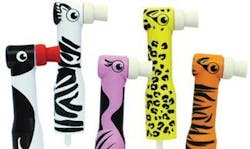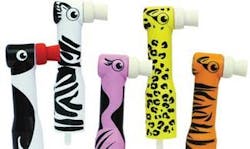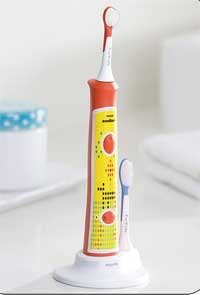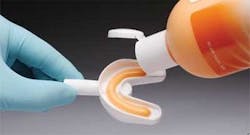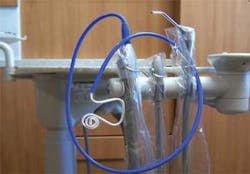Pediatric products
that make life easier in any dental office
by Cathy Hester Seckman, RDH
Pediatric hygienists are always tweaking their approach to little ones in an attempt to be more accessible, easier to talk to, less threatening, and more helpful. Even with years of experience, it can be hard to know exactly what will flip the switch in a child's brain from fearful to trusting, cringing to reaching, or dread to eagerness, or at least acceptance.
Dental product manufacturers know this, so they're always trying to come up with one more innovation to pique a child's interest or make a hygienist's job easier.
One of the most adorable products I've seen recently is the Zooby prophy angle from Young Dental. One version is bright yellow, and with a good imagination it looks like a cheetah. Another is decorated in swirly black and white and reminds me of a penguin — a very popular animal with the preschool set. The soft web, latex–free angles fit all slow–speed handpieces, and are made in the U.S. Besides Chase the Cheetah and Penelope the Penguin, there are Francesca the Flamingo, Talon the Tiger, and Zoe the Zebra. Matching stuffed animals are included free with every box of prophy angles through March.
You've all been part of this scenario with a fearful child in the chair. “Kaden, let me show you my electric toothbrush,” you say brightly. “Do you have one like this at home? See, mine goes around in a circle and polishes your teeth. Here, let me polish your fingernail so you can see how it tickles.”
At that point Kaden cringes, buries his head against his mother's leg, and wails, “I don't want toooooooo!”
But imagine how things might be different if you could say, “Hey, Kaden, look at my penguin! Can you guess her name? Do you have any penguins at home? Penelope's going to help me polish your teeth. Watch what she can do!”
Check out the new cartoon prophy angles at www.youngdental.com.
For parents who want to gently introduce their toddlers to power brushing, there are many good choices. Most discount stores have a wide variety of kid–themed power brushes at prices to fit anyone's budget.
Philips Sonicare, makers of the well known Sonicare power brushes, has entered the pediatric market with the Sonicare for Kids (S4K), a brightly colored sonic brush with a gentle side–to–side motion designed specifically for young beginners. The ergonomic brush, just right for pudgy little hands, has two head sizes to accommodate growth. Interchangeable front panels offer kids a choice of colors. There are two power modes — one for young children, and one for more experienced power brush users. With each use, a special KidTimer gradually extends the initial one–minute brushing time until the child is brushing for a full two minutes. Music sounds at intervals to remind the child to switch brushing areas. Learn more about the S4K at www.sonicare.com.
Another recent entry to the power brush market is the Sunstar Americas GUM® Crayola™ Timer Light Toothbrush. The brush, made with Dome Trim ultra–soft bristles and a narrow, tapered head, is designed for 4– to 11–year–olds and is available in red, blue, green, and yellow. Like other Crayola™ brushes, the brush has a suction cup on the end to keep it upright and clean. Two color coordinated lights flash for 60–second intervals to help kids brush longer. More information on these brushes can be found at www.sunstaramericas.com.
Children with taste phobias have good reason to dread a visit to the dental office. From the prophy paste to the fluoride to the topical anesthetic and impression material to the samples of toothpaste and dental floss, nearly everything is flavored. Sunstar Americas has solved part of the problem with their Paste–Free Prophy™ angles. The angles are up to 50% less abrasive than a medium–grit prophy paste.
When fussy little Maya comes into your operatory loudly complaining that she hates all those yucky flavors, you can help her avoid at least one of them by offering a paste–free prophy. Free samples are available at www.sunstaramericas.com.
Here's another problem pediatric hygienists face — the touchy, nervous, my–tongue–moves–a–hundred–miles–an–hour second grader who can't stop pushing the saliva ejector out of her mouth during a fluoride treatment. Premier has a new product invented by a hygienist — a combination fluoride tray/saliva ejector holder. The E–Vent dual arch fluoride tray has a built–in port into which a saliva ejector tip can be securely inserted. If that antsy second grader closes firmly and sits with her chin tilted slightly downward, saliva and excess fluoride flow directly into the front–mounted ejector with less propensity for gagging. The trays are soft for good flexibility, and according to Premier, the medium size fits three–quarters of the gel/foam treatment population. Besides fluoride application, the trays are great for in–office desensitizing treatments and remineralization treatments. Information on the E–Vent trays is at www.premusa.com.
Wobbly saliva ejectors aren't just a problem with fluoride treatments. How many times a day do you mentally curse these ungainly things while trying to apply sealants in a very wet mouth? Out of frustration, hygienist Ann Arrington invented the Blue Boa.
“It was for the ultrasonic at first,” she reports, “though I found out later how helpful it is with sealants as well. I couldn't see, couldn't suction, I was bending my back. The saliva ejectors pulled out of place. I decided there needed to be something better, some kind of lightweight adapter. The obstacles to overcome were low–volume suction, heavy tubing, displacement, and not enough length on the suction hose. I eliminated all these drawbacks.”
She took her idea to a tubing manufacturer. “I said, ‘This is what I need, can you help me?' They said no, so I asked who else they knew. I just went down the line, asking questions, until I found a manufacturer who could make what I wanted.”
So now, because of one hygienist's frustration, we have the Blue Boa, which is simply a 42–inch length of dental tubing that adapts a low–volume saliva ejector (either the Orsing Hygoformic® or the Otis Formeject®) to high–volume hosing. Though the Boa was invented to help with ultrasonic scaling, it also works to effortlessly maintain a dry field for sealant placement. Boas can be ordered at www.theblueboa.com.
Preteens who still have posterior baby teeth are becoming interested in whitening products, of all things, and a good hygienist needs to steer them in the right direction. Girls look in the mirror at those pearly white deciduous cuspids and compare them to their big, yellowish permanent incisors. And they panic. I recently saw a 10–year–old with blisters on the roof of her mouth. She had tried to use her mother's bleaching gel – with her mother's custom tray – and enough gel oozed onto her hard palate to cause blisters.
One gentle solution for girls who are too young for traditional whitening products is NuvoraWhite lozenges. The lozenges, which use Nuvora's SuRe™ technology, whiten teeth with carbamide peroxide while they kill bacteria and impede biofilm with essential oils and xylitol, maintain pH balance with sodium bicarbonate, and neutralize bad breath with zinc. From the viewpoint of a 10–year–old girl, the great things about the lozenges are that they're mild, taste good, are relatively inexpensive, and are not technique–sensitive. All a girl has to do is put one in her mouth twice a day, with no worries about trays and gel or applying a sticky strip just the right way. Look for the lozenges at www.nuvorainc.com.
For the reluctant teen who slouches into your operatory with a phone in one hand and an iPod in the other, here's a product that can get his attention. Orasphere, which markets patient education material, offers an iPod Touch application. Routine dental procedures are explained on animated videos, which Orasphere says can save time and energy, increase patient acceptance, and answer post–treatment questions.
Patients who don't have an iPod can be shown the videos on the office's iPod, handily included with purchase of the software. Information is at www.orasphere.com.
For any parent in a pediatric practice who wants her children to be caries–free, GC America products are a good choice. Introduced in 2009, the Saliva Check Mutans Kit is the first chairside risk assessment test for quick detection of higher levels of Streptococcus mutans (S. mutans), the prime etiologic agent of human dental caries. Patients with more than 500,000 CFU/mL of S. mutans in saliva have a high caries risk.
Besides monitoring bacteria levels, this chairside test educates and motivates patients to maintain a healthy oral environment. It simplifies and visually communicates the essential concepts of tooth decay. Information on Saliva Check Mutans is at www.gcamerica.com.
One of the most exciting new products in dentistry is a caries infiltrant called Icon, distributed by DMG America. Imagine how your pediatric patients and their parents will love to hear that an early caries lesion can be treated without anesthesia or drilling.
Deborah Dopson Hartley, RDH, who works with DMG, describes Icon as “a microinvasive technology specifically used to fill, reinforce, and stabilize demineralized enamel.” Rather than using mechanical means to remove decay and replace it with filling material, Icon technology uses physics to stabilize the lesion.
The technology is meant for incipient interproximal decay and smooth–surface carious white spot lesions. A diffusion barrier is created within the lesion so caries–causing acids are blocked and the demineralization process is stopped.
Because Icon is so new, there is no general consensus on whether hygienists will be able to use it themselves. Kathy Schroder, manager of the governmental affairs division of the ADHA, believes that if the procedure becomes accepted in the dental community, the issue might never arise. “Application of anticariogenic agents is one of the basic and traditional hygiene services, and is part of the hygiene scope in every state,” she said. “Many states include a nonspecific general statement that hygienists may apply anticariogenic agents — without limiting them to specific agents.”
Watch Icon demonstration videos at www.drilling–no–thanks.com/us/home.html.
Many of these products might be a good fit for your office, whether you specialize in pediatrics or not. After all, small patients who come through your door are depending on you to care about them, and to make their visit as easy as possible. Every product we can find to make that happen is a worthwhile product.
Note: The author has a financial relationship with GC America, Nuvora, and Philips Sonicare.
About the Author
Cathy Hester Seckman, RDH, is a frequent contributor based in Calcutta, Ohio. Besides working in a pediatric dental practice, Seckman is a prolific freelance writer, a book indexer, and a speaker on dental and writing/indexing topics. She can be reached at [email protected].
